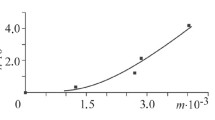We perform the experimental investigation of the influence of hydrogen sulfide on the signals of magnetoelastic acoustic emission (MAE). The action of hydrogen-sulfide media on the parameters of МАЕ signals of reversely magnetized specimens of 15 steel and 2 steel after holding in these media for 173 h at room temperature is investigated. The degraded structure of the material causes a decrease in the mobility of non-180° domain walls because the number of their pinning centers increases and, as a result, the sum of amplitudes of the MAE signals in damaged specimens decreases.



Similar content being viewed by others
References
V. I. Tkachev, V. I. Kholodnyi, and I. N. Levina, Serviceability of Steels and Alloys in Hydrogen Atmospheres [in Russian], Vertikal', Lvov (1999).
D. C. Jiles, “Review of magnetic methods for nondestructive evaluation,” NDT International, 21 (5), 311–319 (1988).
Z. T. Nazarchuk, O. E. Andreikiv, and V. R. Skal’s’kyi, Evaluation of the Hydrogen Degradation of Ferromagnets in Magnetic Fields [in Ukrainian], Naukova Dumka, Kyiv (2013).
V. V. Volkov, V. F. Kumeishin, М. Yu. Chernikhovskii, Yu. P. Lobastic, and S. М. Lepskii, “On the acoustic emission of reversely magnetized ferromagnets in magnetic fields,” Defektoskopiya, 4, 21–28 (1986).
N. A. Glukhov and V. N. Kolmogorov, “Relationship between the parameters of acoustic noise in reversely magnetized structural materials,” Defektoskopiya, 2, 26–29 (1988).
B. P. Klym, E. P. Pochaps’kyi, and V. R. Skal’s’kyi, “Information-and-computational system for processing the signals of magnetoelastic acoustic emission,” Tekh. Diagnost. Nerazrush. Kontr., No. 2, 43–49 (2008).
V. Skalsky, Ye. Pochapskyy, B. Klym, S. Hirnyj, Ya. Tolopko, and P. Dolishniy, “Instrumentation for magnetoacoustic emission diagnostics of ferromagnetic materials,” Visn. TNTU, Special Issue, Part 2, 82–88 (2011).
NACE Standard MR-0175-96. Standard Material Requirements. Sulfide Stress Cracking Resistance. Metallic Materials for Oilfield Equipment, National Association of Corrosion Engineers, Houston (1996).
O. I. Radkevych and V. I. Pokhmurs'kyi, “Influence of hydrogen sulfide on the serviceability of materials of gas-field equipment,” Fiz.-Khim. Mekh. Mater., 37, No. 2, 157–170 (2001); English translation: Mater. Sci., 37, No. 2, 319–332 (2001).
M. S. Khoma, “Problems of fracture of the metals in hydrogen-sulfide media,” Fiz.-Khim. Mekh. Mater., 46, No. 2, 55–66 (2010); English translation: Mater. Sci., 46, No. 2, 190–200 (2010).
I. I. Vasilenko and R. K. Melekhov, Corrosion Cracking of Steels [in Russian], Naukova Dumka, Kiev (1977).
Author information
Authors and Affiliations
Corresponding author
Additional information
Translated from Fizyko-Khimichna Mekhanika Materialiv, Vol. 52, No. 5, pp. 124–127, September–October, 2016.
Rights and permissions
About this article
Cite this article
Pochaps’kyi, E.P., Klym, B.P., Rudak, М.О. et al. Application of the Magnetoelastic Acoustic Emission for the Corrosion Investigations of Steels . Mater Sci 52, 742–745 (2017). https://doi.org/10.1007/s11003-017-0017-7
Received:
Published:
Issue Date:
DOI: https://doi.org/10.1007/s11003-017-0017-7




